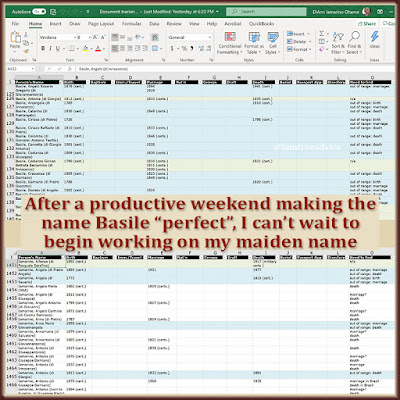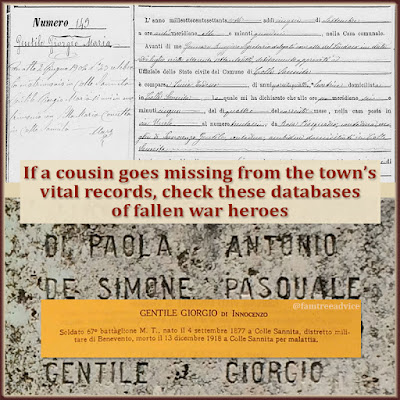You know those Potential Father, Potential Mother suggestions on Ancestry.com? The ones so many people find ridiculous? I decided to check one out today.
I was randomly viewing my tree on Ancestry. I wanted to see how many people could fit on the screen at once. I wish I could see thousands of them at a time.
The results weren't good, but a pair of bright green potential ancestors caught my eye, so I had a look. I didn't realize at the time that they were potential 7th great grandparents for me.
 |
| I usually ignore hints, but this one's from the 1700s. I had to investigate. |
Their last names told me they were from Grandpa Iamarino's hometown. The hometown for which I have the most awesome genealogy book in the world. A book that tells me everyone who lived there in the year 1742.
Antonio Zeolla and Maddalena Pilla were the potential parents of my 6th great grandmother, Libera Zeolla. There were no sources for them in the family tree of my possible cousin. His tree was the source of the hint.
So I turned to my book, "Colle Sannita nel 1742." There's an index that helped me quickly find every household in town with the name Zeolla. There were 19 households with a head-of-household named Zeolla. Household #17 was the one I needed.
In the home of 71-year-old Pietro Giorgio Zeolla, the name Maddalena Pilla jumped out at me. I looked closer and saw she was the wife of Antonio Zeolla. That's the potential couple from Ancestry! But, were they the parents of my Libera Zeolla?
This was a big household with a very long listing in the book. Antonio and Maddalena had 3 young children living there. Their oldest child was 9-year-old Libera.
It's her! My 6th great grandmother Libera Zeolla is in this most wonderful book with lots of relatives. Now I've learned the names of her:
- parents
- two younger sisters
- paternal grandfather
- uncle
- two aunts
- two first cousins (one of whom was already in my family tree)
I now know much more about this family than my possible cousin who's the source of this wonderful hint. Now MY find will become a hint for HIM.
 |
| I never expected such a vague hint to be so fruitful. |
Behold the power of an early, detailed census of your ancestral hometown.
This past Wednesday I reviewed every family in the book with my maiden name. Then I began filling in their missing documents in my document tracker spreadsheet.
Now I'm thinking…I need to find more Potential Fathers and Potential Mothers to investigate. I routinely ignore hints, but I may have some early ancestors hiding there. The key is simple: Do your own research to prove a hint right or wrong.








